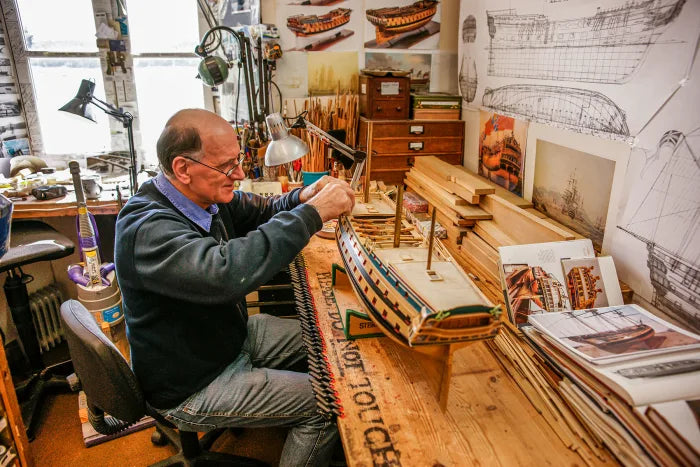
Discover the Fascinating World of Ship Modeling: A Beginner's Guide
Share
Have you ever been captivated by the majestic sight of a historical sailing ship, its sails billowing in the wind, or the powerful presence of a vintage warship? Do you find yourself drawn to intricate craftsmanship and the satisfaction of building something with your own hands? If so, you might just be ready to embark on an exciting journey into the world of ship modeling.
Ship modeling is more than just a hobby; it's a blend of history, artistry, and meticulous skill. It's a chance to connect with the past, to understand the ingenuity of naval architecture, and to create a tangible piece of history in miniature. This guide is designed to introduce beginners to this rewarding pastime and show you why so many enthusiasts around the globe are passionate about it.
A Brief History of Ship Modeling
The practice of creating miniature versions of ships dates back centuries. Ancient civilizations crafted model boats for religious purposes, as toys, or even as offerings. However, the modern form of ship modeling evolved alongside shipbuilding itself. As ships became more complex, detailed models were created by shipwrights and naval architects to aid in design and construction.
Over time, the creation of ship models transitioned from a purely functional practice to a beloved hobby. Individuals began building models for personal enjoyment, driven by a fascination with maritime history and the challenge of replicating these impressive vessels in miniature. Today, ship modeling encompasses a wide range of styles and techniques, attracting enthusiasts of all ages and skill levels.
Exploring the Different Types of Ship Models
The world of ship modeling offers a diverse array of subjects to explore. Here are some popular categories you might encounter:

Historic Sailing Ships: These models replicate iconic vessels from different eras, such as galleons, clippers, and warships of the age of sail. They often feature intricate rigging and beautifully detailed hulls.
Classic Motor Yachts and Liners: From elegant private yachts to grand ocean liners, these models capture the glamour and engineering of early 20th-century maritime travel.
Naval Vessels: This category includes warships from various periods, from wooden frigates to modern destroyers. Modelers often focus on accuracy in terms of armament and design.
Working Models: Some advanced modelers even create radio-controlled (RC) ship models that can navigate on water, adding a dynamic element to the hobby.
As a beginner, you'll likely start with static display models, focusing on the detailed assembly of pre-designed kits.
Essential Tools for the Budding Ship Modeler
Getting started with ship modeling doesn't require a vast investment in tools, but a few key items will make the process much smoother and more enjoyable:
Craft Knife (Hobby Knife): For cutting parts from sprues (for plastic models) or shaping wooden components.
Tweezers: Essential for handling small parts and placing decals.
Files and Sandpaper: For smoothing edges and preparing surfaces for painting.
Plastic Cement (for plastic models) or Wood Glue (for wooden models): To join the various components.
Paint Brushes: A selection of sizes for different painting tasks.
Paints: Acrylic paints are a popular choice for beginners due to their ease of use and water-based cleanup.
Cutting Mat: To protect your work surface.
Ruler and Measuring Tape: For accurate assembly.
As you progress in ship modeling, you may choose to invest in more specialized tools like airbrushes, clamps, and pin vises, but the above list provides a solid foundation for beginners.
The Many Benefits of Engaging in Ship Modeling
Beyond the satisfaction of completing a beautiful model, ship modeling offers a wealth of benefits:

Developing Fine Motor Skills: Working with small parts and intricate details significantly improves dexterity and hand-eye coordination.
Enhancing Patience and Focus: Ship modeling requires concentration and attention to detail, fostering patience and the ability to focus on a long-term project.
Learning History and Engineering: Researching the ships you are modeling provides insights into naval history, shipbuilding techniques, and engineering principles.
Boosting Creativity and Problem-Solving Skills: Modelers often encounter challenges during the building process, requiring creative solutions and problem-solving abilities.
Providing a Sense of Accomplishment: The feeling of pride and accomplishment upon completing a detailed model is incredibly rewarding.
Joining a Community: The ship modeling community is vast and supportive, offering opportunities to connect with fellow enthusiasts, share knowledge, and learn new techniques.
Ready to Set Sail on Your Modeling Journey? Explore our online store!
The world of ship modeling awaits! It's a hobby that combines historical appreciation, artistic expression, and the satisfaction of hands-on creation. Whether you're drawn to the elegance of a tall ship or the power of a naval vessel, there's a model out there for you.
Take the first step today. Explore the different types of ship model kits available, gather your basic tools, and prepare to immerse yourself in this captivating and rewarding pastime. You might just discover a lifelong passion for bringing these magnificent ships of the past back to life, one meticulous piece at a time.
